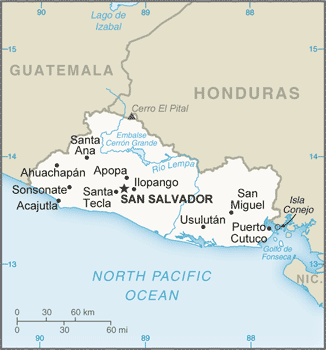America > Salvador: Weather, Map, Costs and Travel Guide

Salvador : When and where to go?
Click on a city for complete climate and weather tables
| Town | Jan | Feb | Mar | Apr | May | June | July | Aug | Sept | Oct | Nov | Dec |
| San Salvador |  |  |  |  |  |  |  |  |  |  |  |  |
Salvador: Climate & Weather
The country suffers from a hot subtropical climate, but the altitude of a good part of the country makes it possible to temper the heat wave, and the coast alone displays very high temperatures.
The rainy season, also more pronounced on the coast, lasts from May to October, with intense thunderstorms and possible hurricanes.
The dry season is between November and April and is the best time to visit El Salvador, where temperatures range from 20 to 35 ° C.
Weather today

Clear
Wind: 3 km/h
Precipitation forecast: 0 mm
> Full report and 7-days forecast
Data updated at 05:43 (local time)
At that time, the weather was:
 21 °C / Clear
21 °C / Clear
Salvador: Map

Sponsored links
What to do in Salvador
In San Salvador, the capital, you can visit the Metropolitan Cathedral, the National Theater and the all-marble National Palace (seat of government), as well as the church of San Ignacio de Loyola with its beautiful facade. A few kilometers from the city, you will discover the panchos and their preserved traditions, the city of San Sebastian and its renowned fabrics as well as the nearby Ilopango lake where you can practice water sports, the village of Chalchuapa and right next to the Mayan ruins of Tazumal, but also, less renowned, those of Las Victorias, Casablanca, Peme or El Trapiche. The site of Joya de Ceren is registered at UNESCO, there are scenes of Mayan life immortalized after the eruption of the volcano Loma Caldera in the year 600.
In the northeastern part of the country, explore the Monte Cristo National Park with its moist forest covered by hiking trails: the village of Metapan will serve as a base from which to discover a rich natural landscape with amazing animals, Toucans, cougars, spider monkeys, quetzals, otters, ocelots, and punctuated with waterfalls.
To the west, visit the National Park of the Volcanoes: you will discover the volcano Izalco, the youngest, the Cerro Verde, which is no longer active, the Santa Ana, at the foot of which is Lake Coatepeque, in reality A crater filled with blue water. Many walks are available to you in this area.
Take the Route des Fleurs, which connects through the Sonsonate mountain to Ahuachapan, winding between the coffee plantations which in May splash the landscape of the white flowers of the coffee trees and stop in the small authentic villages in Heart of this country.
Salvador: The basics
The current currency is the US Dollar (USD).
Transport: You will land at Ilopango International Airport, one of the most modern in Central America, 13 km from San Salvador, but from Paris you will have to stop in Madrid or Bogota. To move around the country, you can rent a car, but out of the cities only circulate during the day and if possible in convoy. Beware of poor road conditions, lack of lighting and animals crossing the roadway. There are buses that connect the cities to each other and are very inexpensive.
Budget: You will eat for about 4 times cheaper than in France, but the cost of accommodation is quite high.
Health: Drink only bottled water. It is advisable to have your classic vaccinations up to date and to add hepatitis A vaccine. Take a treatment against malaria and protect yourself against mosquitoes, which also transmit dengue, especially during the rainy season, and The chikungunya. There are also many stray dogs and it may be prudent to be vaccinated against rabies.
Safety: El Salvador is an earthquake zone, so ask before planning a hike. Same for volcanic eruptions. Moreover, the crime rate remains high, and it is better not to linger in downtown San Salvador, especially after dark.
Shopping: To bring in souvenir, small Mayan statuettes, spices, multicolored hammocks, or a bag of coffee of the vintage, excellent.



